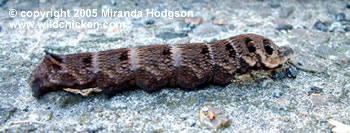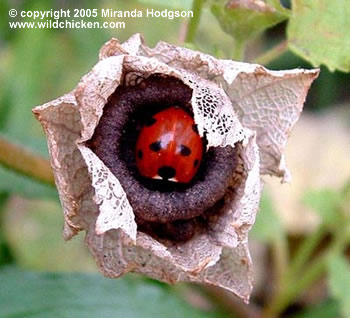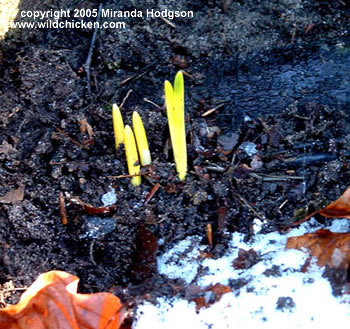October 14th 2005 - Autumn tidy up - just say 'No'
Glad to say that the pond has cleared completely after all the upheaval of having to replace the lining. It looks a bit empty without the plant growth that was there before, but that will return next year. The remaining tadpoles, about 25 of them, seem to have got over the short period of turbulence and look fat and lively. I don’t know what they’ll do over the winter, though there is enough mud at the bottom for them to tuck into.
"...it would be fascinating, if it were possible, to explore it from the frog’s point of view, to share in what they see "
We haven’t seen much of the larger frogs, but have seen many of the younger ones about the garden. They seem to be especially keen on the bed right outside the front living room window, which is full of growth. It must be a damp and shady, forest-like, wonderland of stems, leaves and cobwebs; it would be fascinating, if it were possible, to explore it from the frog’s point of view, to share in what they see.
I see them when I’m trimming round the edge of the lawn. There are always more of them just there; they jump from the grass on to the soil and then pause for a moment before disappearing into the shady vegetation. That’s one of the reasons that I don’t use long handled lawn trimmers, to see what’s going on in the plant beds. It’s a good opportunity to have a close-up look at the plants and see how they’re doing, as well as gauging the number and variety of residents.
Along with the frogs, there are beetles and many different types of spiders running about over the soil and it’s interesting to stop and watch them for a moment. Occasionally at this time of year, we’ve seen the caterpillars of the Elephant Hawk Moth undulating around the base of plants. Whilst we haven’t seen the moths themselves, it’s good to know that they’re about and I’m glad that we have some night scented flowers growing. These include Verbena bonariensis, Nicotiana sylvestris, Matthiola bicornis (Night-scented stock), and Oenothera biennis (Evening Primrose).

Elephant Hawk Moth caterpillar that we saw on the driveway
"My method is to clip round the edge and throw the clippings back onto the lawn"
I have a pair of Wolf shears, like giant scissors, and find them excellent for trimming. It means crawling round the whole perimeter of the lawn, sometimes getting damp knees if I don't use kneelers, but you do get to see what’s going on. My method (‘méthode spéciale’, we call it) is to clip round the edge and throw the clippings back onto the lawn. Any grass that has sprouted in the beds gets pulled up and thrown onto the lawn too; same with weeds, as long as they aren’t too big. Then, the lawn mower acts like a vacuum cleaner and picks it all up as the lawn is cut. Easy.

Autumn leaves
This is supposed to be the time of year for tidying up the garden and ‘putting it to bed’, but that won’t happen here. I’ll keep on top of dead heading until the plants succumb to frost and stop flowering, but I shan’t be doing a lot of cutting back or digging until spring. There are many moths that overwinter in the shallow soil during the pupal stage, so autumn digging will be left so as not to disturb them. I can pull out weeds by hand and will put down a mulch of compost, but that’s it.
You still see gardens that are based entirely on bedding plants, which are stripped out at the end of September to leave six months of bare soil. Looking at them, I can’t help listing to myself the disadvantages of doing that. Apart from looking incredibly dull, it can’t be good for the soil or the wildlife. Here especially, where the soil is sandy, any nutrients will be washed away by the winter rains and may also compact it. There will be no forests of stems for insects to hibernate in, meaning that there won’t be a food supply for wild birds to find during the cold weather when they really need it.

A ladybird sheltering in a seed head.
"Birds of the thrush family will spend hours a day rummaging through leaves to find the insects, slugs and snails"
Clearing up fallen leaves takes away another winter habitat. Birds of the thrush family will spend hours a day rummaging through leaves to find the insects, slugs and snails which have crawled under them. Whilst you don’t want leaves covering the lawn and plants, where they can cause fungal infections, they can be pushed to the back of the bed where they’ll be out of the way. They’ll help to condition the soil too, as earth worms will pull some of them down under the surface. Leaves can also protect the emerging shoots of bulbs.

Carefully move the leaves aside to see the new shoots of bulbs, but remember to put the leaves back afterwards.
Remaining seed heads will provide wild birds with a source of seeds to forage and will look pretty when they’re frosty. Untrimmed stems will give some plants extra protection from the cold, which they may need if we’re to have the cold winter that the Met Office is currently predicting. So, unless it’s a plant that turns into a horrible soggy mess with the first frost, most of them can stay where they are. If any are cut, they can be bundled up and put in corners to create shelters for solitary wasps, bees and spiders.
It sounds like an ideal excuse to be lazy, avoiding the autumn tidy-up, but remembering all those creatures who need somewhere to stay over winter will help them to thrive and increase their numbers. It isn’t as if we’ve had a bumper year for any kind of insect this year. From what I’ve read, numbers have been down in many places in the UK, with fewer wasps, bees, butterflies, and hoverflies to name a few. They’re all good creatures and we need them, so I’m going to try and give them some of the help they need.
© Copyright Miranda Hodgson 2005